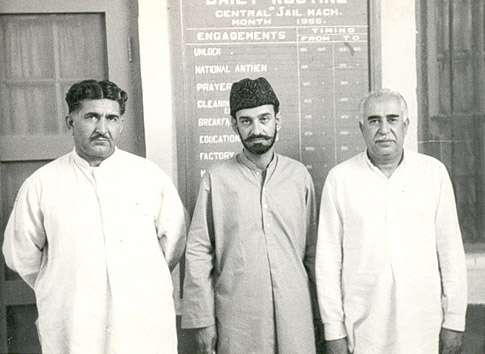Ataullah Mengal
Ataullah Mengal (Urdu: سردار عطااللہ خان مینگل), popularly known as Sardar Ataullah Mengal, is a well-known political and feudal figure of Pakistan hailing from Balochistan. He has been campaigning a nationalist and separatist movement in Pakistan for over four decades. He is the head of the Shahizai Mangal tribe. He was born in 1929 in Wadh, and became the first Chief Minister of Balochistan during Zulfikar Ali Bhutto's premiership from 1 May 1972 to 13 February 1973.
Sardar Ataullah Khan Mengal | |
|---|---|
| 1st Chief Minister of Balochistan | |
| In office 1 May 1972 – 13 February 1973 | |
| Preceded by | Office created |
| Succeeded by | Jam Ghulam Qadir Khan |
| Personal details | |
| Born | 1929 (age 90–91) Wadh, Balochistan, Pakistan |
| Nationality | |
| Political party | Balochistan National Party (Mengal) |
| Children | Akhtar Mengal (son) |
It was reported that Sardar Ataullah Khan Mengal was one of many candidates considered for the position of President of Pakistan after the resignation of Pervez Musharraf.[1]
Joining National Awami Party
In 1958, Ataullah Mengal along with chief of Marri tribe Khair Bakhsh Marri joined the National Awami Party (Wali) of Khan Wali Khan and developed a close friendship with Wali Khan over the next decade. Ghaus Bux Bizenjo and Gul Khan Nasir already were members of NAP.. In the 1970 general election, National Awami Party swept the provinces of Balochistan and North-West Frontier Province, thus forming governments in each of them. In Balochistan, Ataullah Mengal was made the first chief minister of the province.
Chief Minister of Balochistan
Ataullah Mengal is from an ancestry of powerful feudal sardars. He won the provincial seat from his native wadh district (khuzdar) and was installed as the chief minister on 1 May 1972, the day the martial law was lifted from the country. In his short time as Chief Minister he pushed through many initiatives, in which the province's first university, medical college and board of secondary education were set up as well as the first industrial city of the province, in Hub, Lasbela District.
Dismissal of NAP-led government
Despite Mengal's best efforts, the NAP government was plunged into several crises which culminated with his governments dismissal.
As there was a provision that employees in the federating provinces would return to their province of origin after the dissolution of the One Unit. Most of the officers insisted on leaving this was despite the fact, Sardar Ataullah Mengal as chief minister moved a resolution in the Balochistan Assembly to do away with the domicile category and suggested that those who had spent several generations in the province should be treated as locals (Rahman 2006). Shaeed Sardar Arif Aziz Muhammed Hassani was also there. Shaheed Sardar Arif Aziz Muhammed Hassani was also the member of NAP. and after that he joined the Baloch National Movement that was the main history. It was later on alleged that the officers were incited to leave through the efforts of PPP supporters and the then Chief Minister of Punjab Ghulam Mustafa Khar.
Unable to exercise any effective authority, Ataullah Mengal turned to the Baloch Student Organisation to assist in security.
Discovery of London Plan
The policing crisis also gave way to a subsequent intra tribal conflict that broke out, which again the Baloch nationalists believe was fomented by the then Interior Minister Abdul Qayyum Khan. However, the final straw was the discovery of arms in the Iraqi embassy in Islamabad and Nawab Akbar Bugti's declaration of the London Plan, that alleged that NAP-led governments in Balochistan and NWFP was seceding to gain independence from Pakistan. Hence, Zulfikar Ali Bhutto's government used the pretext of arms shipment from Iraq to insurgents and dismissed the Balochistan provincial government in 1973 and declared Presidential Rule. Ataullah Mengal and his colleagues, including Ghaus Bux Bizenjo and Khair Bakhsh Marri were arrested along with other NAP leaders.
Hyderabad tribunal

A commission, later known as Hyderabad tribunal, was set up by the PPP-led government and was used to convict the NAP leaders, despite its dubious legality and now discredited work. Zulfikar Ali Bhutto, the then Prime Minister of Pakistan, also suppressed the insurgency in Balochistan by using the air force and with the co-operation of the regime of the Shah of Iran. Some tribals, however, did not join the revolt and collaborated with the government in suppressing their co-tribals. Among the tribals who collaborated with the government and the Pakistani military-intelligence establishment were the Jamalis, led by the family of Mir Zafarullah Khan Jamali, who became the premier during General Pervez Musharraf's regime.
After the ouster of Zulfikar Ali Bhutto's government by General Muhammad Zia-ul-Haq, negotiations for the winding up of the Hyderabad tribunal and the release of all detainees was initiated leading to their eventual release in 1979.
Differences with NAP leaders
By this time a clear divide between NAP leader Wali Khan and Baloch leaders Ataullah Mengal and Ghaus Bux Bizenjo. Mengal and many other Baloch nationalists increasingly believed that the Army was responsible for a brutal military operation and that they should be opposed by force, whereas Wali Khan felt more personal bitterness towards Ali Bhutto as he felt Bhutto had ordered his assassination on more than one occasion. This divide turned into a total split when Ataullah Mengal allied himself with Khair Bakhsh Marri and attempted to take over the National Democratic Party (a successor to the then banned NAP). Sherbaz Khan Mazari, president of the National Democratic Party and a champion for the Baloch cause tried to reconcile these differences but did not succeed. When this attempt failed Ataullah Mengal left the party.
After Bhutto was deposed in a military coup by General Muhammad Zia-ul-Haq in 1977, Rahimuddin Khan was appointed the province's governor and martial law administrator, beginning a tenure characterised by hostility towards the sardars. Mengal subsequently went into exile and took sanctuary in the United Kingdom that year, where he established contact with the authorities of the erstwhile Soviet Union through the regime in Kabul and received financial and logistics support from Moscow.
Founding of Sindhi Baloch Pushtoon Front
Ataullah Mengal participated in the founding of Sindhi Baloch Pushtoon Front in London on 31 March 1985.[2]
Return to Pakistan and founding of BNP
Sardar Ataullah Mengal returned to Balochistan in 1995, after which he formed the Balochistan National Party, which emerged as the largest political party in the province. Mengal's youngest son, Sardar Akhtar Mengal served as the Chief Minister of Balochistan in 1997, during the premiership of Nawaz Sharif.
Mengal's son, Akhtar, was involved in a standoff with Pakistani police at his Karachi house in April 2006 after his bodyguards kidnapped three government employees who he accused of attempting to kidnap his children.[3] The kidnapped men were later released and the standoff ended after a week.[3][4]
See also
- Mengal
- Khan Wali Khan
- Sardar Akhtar Mengal
- Mir Gul Khan Naseer
- Mir Ghaus Baksh Bizenjo
- National Awami Party
- Balochistan National Party
- List of political parties in Pakistan
References
- Top contenders for office of president Archived 16 January 2009 at the Wayback Machine
- Christophe Jaffrelot (15 July 2015). The Pakistan Paradox: Instability and Resilience. Oxford University Press. pp. 113–. ISBN 978-0-19-061330-3.
- Schmidle, Nicholas. To Live of Perish Forever, 2009, pg. 81–82.
- High drama grips DHA as Mengal’s house besieged Archived 14 April 2008 at the Wayback Machine
- Independent Baluchistan? Ataullah Mengal's 'Declaration of Independence', Lawrence Lifschultz, Economic and Political Weekly, Vol. 18, No. 19/21, Annual Number (May 1983), pp. 735–737+739+741+743-745+7 47+749+751-752. Published by: Economic and Political Weekly
External links
- Rahman, Shamimur. "Nothing but provincial autonomy" DAWN Magazine, 12 February 2006. Last accessed on 21-02-06
| Political offices | ||
|---|---|---|
| Preceded by Post created |
Chief Minister of Balochistan 1972–1973 |
Succeeded by Jam Ghulam Qadir Khan |
